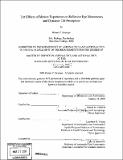The effects of motion experience on reflexive eye movements and dynamic tilt perception
Author(s)
Ocampo, Robert P. (Robert Paul)
DownloadFull printable version (9.854Mb)
Other Contributors
Massachusetts Institute of Technology. Dept. of Aeronautics and Astronautics.
Advisor
Daniel M. Merfeld and Lawrence R. Young.
Terms of use
Metadata
Show full item recordAbstract
Measured differences between human and primate VOR may derive from disparate experiences with psychophysical motion stimuli. To test this hypothesis, horizontal and torsional eye movements, as well as roll tilt perception, were measured in both "naive" and "experienced" human subjects during 0.5 Hz sinusoidal roll motion. Between these measurement sessions, subjects experienced pseudo-random roll tilt adaptation sessions. For half of the subjects, these adaptation sessions occurred in the light. Subjects participated in 12 measurement sessions and 9 adaptation sessions over the course of three days. (1) The presence of visual cues did not significantly affect horizontal or torsional VOR, but did adversely influence perception of roll tilt as measured using a somatosensory bar. (2) Torsional VOR followed a pattern of habituation and/or adaptation for naive and dark-adapted subjects. (3) Experienced subjects made horizontal eye movements of significantly larger amplitude than those made by naive subjects. (4) The motion paradigm yielded a significant decrease in torsional amplitude without a corresponding decrease in horizontal amplitude. These last two findings suggest experience does not affect the horizontal VOR. Consequently, the hypothesis that human/primate horizontal VOR differences stem from dissimilar motion experience is not supported. Primate and human VOR must continue to be studied separately.
Description
Thesis (S.M.)--Massachusetts Institute of Technology, Dept. of Aeronautics and Astronautics, 2008. Includes bibliographical references (p. 161-164).
Date issued
2008Department
Massachusetts Institute of Technology. Department of Aeronautics and AstronauticsPublisher
Massachusetts Institute of Technology
Keywords
Aeronautics and Astronautics.